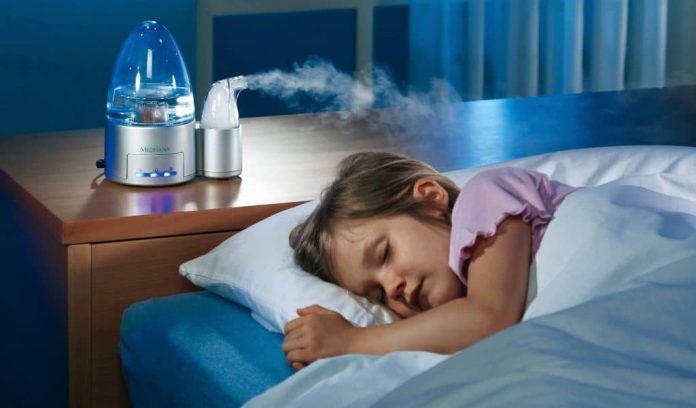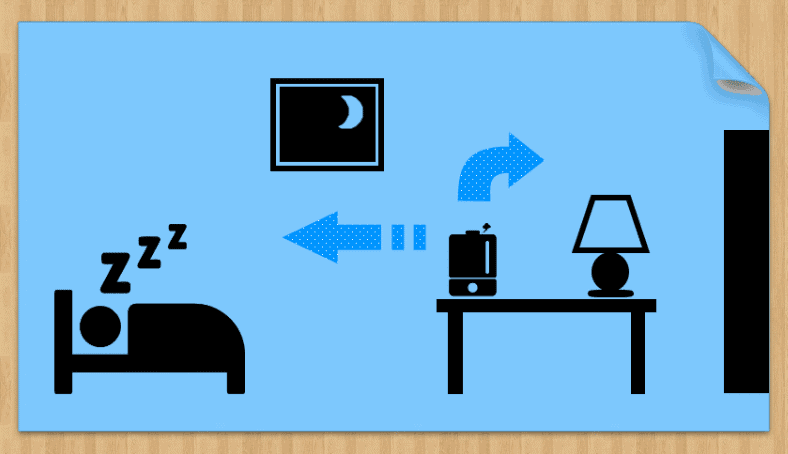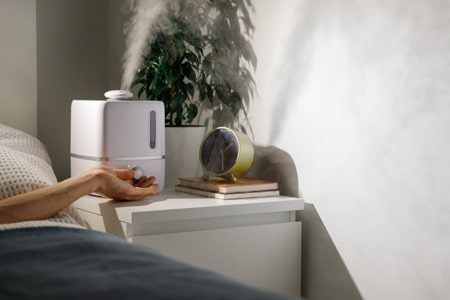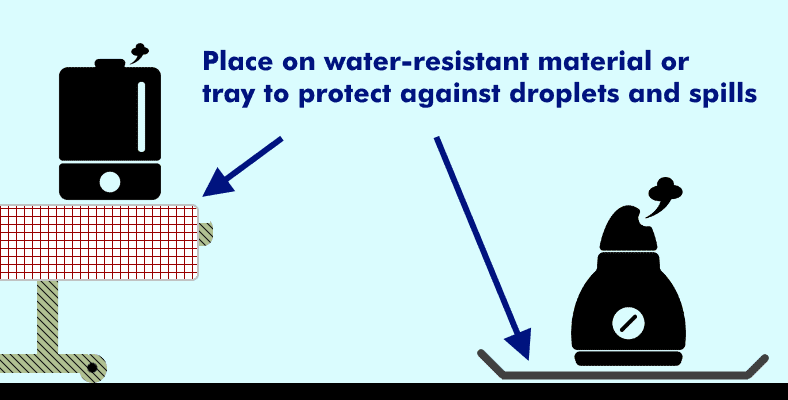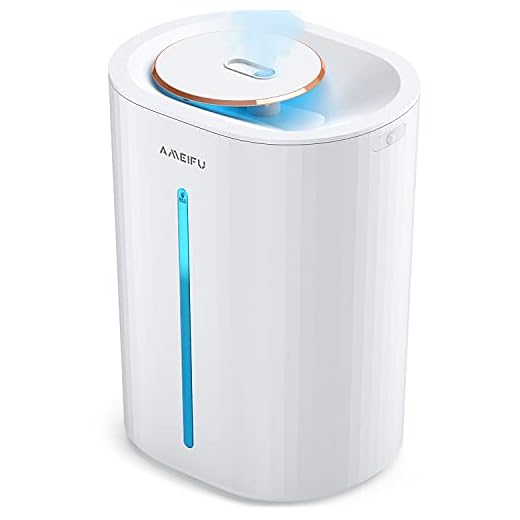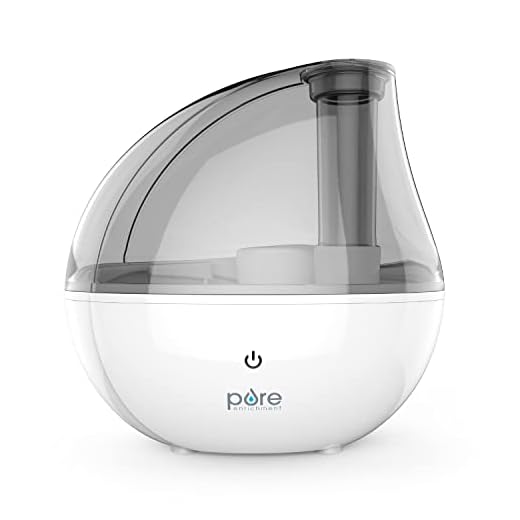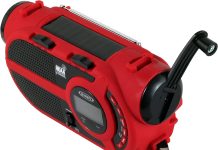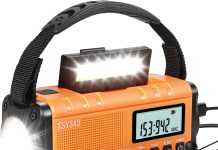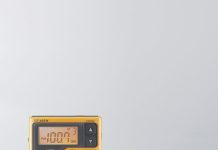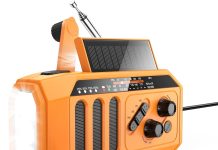You’re not alone if you’ve ever wondered the perfect spot to place a humidifier in your bedroom.
Finding the ideal location for this much-needed device can make all the difference in creating a comfortable and healthy sleep environment.
In this article, we’ll explore the importance of proper humidifier placement and how close it should be to your bed.
By understanding the factors to consider and the benefits of strategic placement, you’ll be well on your way to a rejuvenating night’s sleep.
Review contents
Where to Place a Humidifier: How Close Should It Be to Your Bed?
Humidifiers are essential home appliances that can help improve indoor air quality by adding moisture to the air. They can alleviate symptoms of dry skin, allergies, and respiratory issues, promoting better sleep and overall well-being.
However, the placement of a humidifier is critical to its effectiveness and safety.
In this article, we will delve into the importance of proper placement, factors to consider, recommended distance from your bed, benefits, and risks of placing a humidifier near your bed, alternatives to consider, ideal room humidity levels, best locations for rooms with and without air conditioning, as well as tips on humidifier placement.
Importance of Proper Placement
Proper placement of a humidifier is vital because it determines how effectively it can moisturize the air and relieve dryness.
Placing the humidifier in the right location optimally distributes moisture across the room, creating a comfortable and healthy environment for you to sleep in. Moreover, proper placement reduces the risks of using a humidifier, such as bacteria or mold growth.
Factors to Consider
There are a few factors to consider before deciding where to place your humidifier. Firstly, you should evaluate the size of your bedroom. Larger rooms may require a giant humidifier or multiple units to humidify the space adequately.
Additionally, consider the layout of your room, including the position of doors, windows, and air vents. These factors can affect the circulation of moist air and may impact the effectiveness of your humidifier.
Recommended Distance from Your Bed
When placing a humidifier, the distance from your bed is crucial. While having the humidifier too close can result in excess moisture and potential discomfort, placing it too far away may not provide the desired benefits.
Experts recommend positioning your humidifier at least three feet away from your bed. This distance allows for adequate moisture dispersion without directly subjecting you to too much humidity.
Benefits of Placing a Humidifier Near Your Bed
Placing a humidifier near your bed offers several advantages. One significant benefit is that it can directly address issues such as dry throat, nasal congestion, and dry skin that often disturb sleep. By placing the humidifier near your bed, you can experience targeted relief and wake up feeling refreshed.
Furthermore, having a humidifier near your bed can alleviate snoring and improve the quality of your sleep.
Dry air can irritate the throat and nasal passages, leading to snoring and interruptions in breathing throughout the night. By adding moisture to the air, the humidifier can help reduce snoring frequency and intensity, enabling a quieter, more peaceful sleep.
Potential Risks and Precautions
While placing a humidifier near your bed can bring numerous benefits, it is essential to be aware of potential risks and take precautions. The most significant risk is bacteria or mold growth in the humidifier or the surrounding area.
To minimize this risk, ensure proper and regular humidifier cleaning per the manufacturer’s instructions. Additionally, monitor the humidity levels in your room to avoid excessive moisture that can lead to condensation on surfaces or promote mold and bacteria growth.
Furthermore, some individuals may be sensitive to increased humidity levels, resulting in discomfort or respiratory issues. If you experience any adverse reactions, such as difficulty breathing or aggravated allergies, consider adjusting the humidifier’s placement or reducing humidity.
Alternatives to Placing Humidifier Near Your Bed
If you prefer not to place a humidifier near your bed, alternative options can still provide the desired benefits. One option is to place the humidifier in a central location within your bedroom.
This allows moisture to disperse evenly throughout the room, benefiting your sleep without having the humidifier nearby.
Another alternative is to use a whole-house humidifier if you have a forced-air heating or cooling system.
These humidifiers are installed directly into the HVAC system, providing moisture to the entire house and eliminating the need for individual room units. This option ensures consistent humidity levels throughout the home, including your bedroom.
Ideal Room Humidity Levels
Maintaining an ideal humidity level in your bedroom is vital for comfort and health. The recommended humidity level for indoor spaces, including bedrooms, is between 30% and 50%.
This range allows for optimal moisture in the air without creating an environment conducive to bacterial or mold growth.
Use a hygrometer to monitor the humidity levels in your room and adjust the settings on your humidifier accordingly.
Best Locations for Rooms with Air Conditioning
If you have an air conditioning system in your bedroom, it is essential to consider the best location for your humidifier. Placing the humidifier on a flat surface at least three feet from the air conditioning vent is recommended.
This placement ensures that the cool air from the air conditioner does not interfere with the evaporation process of the humidifier and prevents excess moisture from accumulating near the vent, which can lead to potential damage.
Best Locations for Rooms without Air Conditioning
Selecting the right spot for your humidifier becomes even more crucial for rooms without air conditioning.
Place the humidifier near your bed, which can disperse moisture directly around you. This location ensures that you reap the maximum benefits of the humidifier, relieving any dryness-related discomfort you may experience during sleep.
Tips for Humidifier Placement
To optimize the effectiveness and safety of your humidifier, here are some additional tips for placement:
- Avoid placing the humidifier on surfaces that moisture can damage, such as wooden furniture or delicate electronics.
- Keep the humidifier safe from electrical outlets or other potential water sources to reduce the risk of electrical accidents.
- Position the humidifier on a stable and flat surface to prevent accidental spills or tip-overs.
- Consider using a humidifier with adjustable settings to regulate the moisture output based on your preferences and room size.
Remember, it is essential to regularly clean your humidifier, change the water frequently, and follow the manufacturer’s instructions to ensure a clean and efficient operation.
In conclusion, correctly placing a humidifier is critical to reaping its benefits and ensuring comfort and safety.
By considering the recommended distance from your bed, the ideal humidity levels, and alternative options, you can create a conducive environment for better sleep and overall well-being.
Don’t forget to follow the tips for humidifier placement to optimize the effectiveness and longevity of your humidifier. Sleep well and breathe in the fresh, moisturized air!
Do you have a humidifier in your bedroom? If not, it might be time to invest in one! Humidifiers can make sleeping more comfortable and improve the air quality of a room.
But where should you place it? How close should a humidifier be to your bed for optimal results? Here’s what you need to know.
First, let’s discuss why having a humidifier is essential. Low humidity levels can cause dry skin, irritation of the eyes and nose, and even exacerbate allergies or respiratory illnesses. An excellent indoor humidity level helps keep these symptoms at bay and makes breathing easier while asleep.
Finally, we’ll review how far away from the bed a humidifier should be. Depending on the size and type of humidifier used, placement can vary greatly — but general rules apply no matter which model you choose.
Read on to learn more about proper placement when using a humidifier in your bedroom!
Definition Of A Humidifier
A humidifier is an appliance used to raise humidity levels in a home or other enclosed space.
Humidity refers to the amount of water vapor in the air, and higher humidity can help reduce dryness that often occurs during the colder months.
Several types of humidifiers are available today, ranging from whole-house models for large homes and businesses to smaller room-specific units meant for single rooms. The most popular type is an air humidifier, which adds moisture directly into the surrounding air.
When choosing a humidifier, it’s essential to consider both size and power output. A small unit may not be powerful enough to raise humidity levels in larger spaces, while a larger model might be overkill for smaller areas like bedrooms or bathrooms.
Additionally, you should always read and follow manufacturer instructions carefully when operating your machine; improper use can lead to mold growth or damage to furniture and flooring due to excessive moisture buildup.
Finally, when placing your unit near your bed or other living space, ensure it’s at least three feet away to avoid interfering with breathing patterns while sleeping.
This will ensure optimal safety and comfort throughout the night without sacrificing any performance benefits of using a humidifier.
Benefits Of A Humidifier In The Bedroom
Humidifiers offer many benefits when placed in the bedroom. Most notably, they can help regulate humidity levels to promote improved sleep and respiratory relief.
Bedroom humidity should ideally remain between 40-50%, easily achieved with a humidifier. Not only does this range of humidity keep your skin hydrated and comfortable, but it also reduces snoring caused by dry airways.
Additionally, it can relieve allergies or asthma by adding moisture to the air and eliminating irritants like dust mites or pet dander.
The location of your humidifier is critical to maximizing its efficiency. It’s best to place it as close to your bed as possible so that you receive full benefit from the increased relative humidity (RH).
Ideally, it should be no further than 3 feet away for optimum performance. This will ensure that the added moisture reaches all areas of the room without creating too much condensation on windows or walls.
When used correctly, a humidifier provides numerous health benefits while promoting better sleep quality and overall comfort in any bedroom environment. With proper placement and maintenance, you’ll enjoy these advantages every night!
Common Placement Mistakes
Placing a humidifier incorrectly can cause more harm than good. Many people make mistakes when positioning their humidifiers, leading to poor air quality or health risks.
One of the most common placement errors is putting the humidifier too close to your bed.
While it may seem beneficial to have moisture in the air near you while sleeping, it can be dangerous as it increases mold growth around your sleeping area and makes it easier for allergens like dust mites and pollen to linger.
Another wrong-placement mistake involves placing the humidifier in an enclosed space such as a closet or cabinet. This traps humidity inside, which causes condensation on walls, leading to further mold issues. Your humidifier must be placed away from furniture or other items that might block airflow and reduce effectiveness.
Positioning your humidifier correctly is essential for getting the best results and avoiding any potential problems associated with incorrect placement.
Ensure you place your unit at least three feet away from your bed, avoid enclosures, and keep all objects out of airflow if possible. By taking these steps, you will ensure proper operation and get the maximum benefit from having a humidifier in your home.
Important Considerations For Placement
It is essential to consider several factors when choosing the optimal location for a humidifier. The size of the room, safety precautions, and cleaning maintenance should all be considered before selecting a spot in your home.
The first factor to think about is room size. If you have a large bedroom, it may be best to place the humidifier near the center of the space so that moisture can circulate evenly throughout the entire area.
On the other hand, if you have a small bedroom, then placing it closer to your bed might make more sense as it will help ensure that your sleeping environment remains comfortable.
Safety precautions are another critical consideration when deciding where to put your humidifier. Always check with local codes or ordinances regarding any appliance’s proper placement and operation to avoid potential fire hazards or water damage caused by negligence or misuse. Additionally, always keep an eye on cords and wiring; they must not come into contact with liquid at any time during use.
Finally, regular cleaning and maintenance of your humidifier is essential to keep it running smoothly and efficiently. Depending on how frequently you use your unit, this could involve changing filters every few months or even weekly dusting around vents and fans for optimal performance.
Additionally, troubleshooting errors such as low output levels or sudden power outages can often be resolved through basic steps like unplugging/replugging units or resetting settings on digital models.
Overall, many factors must be considered when determining where to set up a humidifier inside your home – from room size and safety considerations to regular maintenance tasks – so research beforehand!
Maximum Distance From Bed
When deciding where to place a humidifier, it is essential to consider the maximum distance from your bed. To maximize its reach and effectiveness in controlling humidity levels, you should aim for a placement no further than four feet away from your sleeping area.
This will ensure that the air around your bed remains at an optimal moisture level. Additionally, if you have multiple bedrooms or other spaces requiring humidification, locate each unit within this minimal distance safety range.
Keep all electrical items out of direct contact with water vapor and liquid droplets the humidifier produces. It is also recommended to avoid placing any electronic device near water sources such as sinks and bathtubs.
By following these guidelines, you can be sure that your bedroom environment stays comfortable without compromising safety measures.
Humidifiers are great devices for improving indoor air quality and helping people breathe easier while they sleep; however, proper placement is essential to benefit them most.
Their efficacy will be significantly reduced. Take time when setting up your new appliance to enjoy its full potential! f placed too far away from the primary space needing humidity control.
Ideal Room Size For Placing A Humidifier Near Your Bed
The ideal room size is essential when placing a humidifier near your bed. Generally speaking, the closer you place the humidifier to your bed, the better. This ensures that moisture will be distributed evenly throughout the entire bedroom.
However, if you have a small bedroom with limited space, positioning a humidifier too close to your bed could cause condensation and make it difficult for air to circulate correctly.
The best way to determine where exactly to place a humidifier on your bed is by measuring the distance between them. Ideally, at least four feet of space between your bed and any nearby walls or furniture should create an overly moist environment.
Additionally, while it may seem counterintuitive, it’s recommended that you keep the humidifier further away from your head than from other parts of your body when sleeping. This helps ensure optimal comfort levels during sleep time.
It’s also advised that you use caution when attempting to position a humidifier directly next to or above your bed since this can lead to potential safety hazards like mold growth or even fire risks due to electric cords being too close to fabrics or flammable materials such as mattresses and pillows. Consider all these factors when deciding the most suitable placement for your unit near the bed.
LEVOIT Humidifiers for Bedroom, Quiet (3L Water Tank) Cool Mist Top Fill Essential Oil Diffuser for Baby Nursery and Plants, 360° Nozzle, Rapid Ultrasonic Humidification for Home Large Room, White
LEVOIT OasisMist Smart Cool and Warm Mist Humidifiers for Bedroom Large Room Home, Auto Customized Humidity, Ultrasonic Top Fill Oil Diffuser for Baby and Plants, Quiet, 4.5L, White
42 used from $56.98
LACIDOLL Humidifiers for Large Room Wholehouse Humidifier 1000 sq. ft 4.2 Gal 16L Floor Humidifier 360° Nozzles Cool Mist Ultrasonic Humidifier Output Top Fill Tower Humidifier for Home Office
Safety Precautions With Humidifiers Near Beds
When it comes to humidifier safety, safe placement is critical. Humidifiers can benefit those suffering from asthma or allergies but must be placed correctly to avoid potential risks.
Keeping your bed at a proper distance from the humidifier is essential, ideally no closer than four feet away. The bedroom should maintain a humidity level of 30-50%, so keeping the humidifier too close could cause an over-saturation of moisture and lead to mold growth or other health hazards.
You must also clean your humidifier regularly to prevent bacteria and mildew buildup and reduce mineral deposits on surfaces such as walls or furniture.
This helps ensure that the air released into your room isn’t contaminated with harmful particles like dust mites, pollen, smoke, and pet dander. Cleaning instructions will vary depending on your unit type, so consult your user manual for specific steps regarding maintenance and upkeep.
Taking certain precautions when using a humidifier near your bed can help create a healthier environment within your home and enjoy its many benefits without compromising safety.
These simple steps can go a long way toward maintaining optimal indoor air quality for yourself and others in your household.
Best Practices For Cleaning And Maintenance
When it comes to caring for your humidifier, there are a few best practices you should follow. Regular cleaning and maintenance of the unit are essential in keeping it functioning correctly and preventing any issues from arising.
Start by regularly wiping down the tank and base of the humidifier with a damp cloth or sponge. This will help remove dust and dirt that could clog up the machine’s filter system. You should also replace the filter on your humidifier at least once every two months, depending on how often you use it. It’s important to check manufacturer instructions as they vary based on model type.
For more intensive cleaning, manufacturers usually provide step-by-step guides on disassembling pieces of the humidifier, allowing access to all components, including filters, tanks, nozzles, etc., which can then be thoroughly cleaned using warm, soapy water or vinegar solution.
Additionally, checking for mineral deposits in areas like tubes or hoses is always recommended since they can reduce airflow efficiency if left unchecked. These deposits can easily be removed with bleach solutions, followed by thorough rinsing before reassembling parts back together again.
Regular cleaning and maintenance following these guidelines are essential to ensuring optimal performance from your humidifier and extending its lifespan. Keeping an eye out for signs of wear or damage, such as cracks, rust spots, or discoloration, will also go a long way in helping you maintain your device for years to come!
Alternatives To Placing A Humidifier Near Your Bed
Several alternatives can be explored when considering how close to place a humidifier near your bed. These include using a bedside air purifier, an essential oil diffuser, air ionizers, air cleaners, and dehumidifiers.
*Using a Bedside Air Purifier: A bedside air purifier is designed to remove dust particles, pollen, pet dander, smoke, and other allergens from the air in any room. They can help reduce asthma or allergy symptoms by clearing out airborne irritants before they reach you while you are sleeping.
*An Essential Oil Diffuser: An essential oil diffuser disperses plant-based oils into the air for aromatherapy benefits, including relaxation and stress relief. It may also add moisture to the air without making it too moist compared to a humidifier.
*Air Ionizers & Air Cleaners: Air ionizers and air cleaners release negative ions that attach themselves to positively charged particles such as dust, pollen, and cigarette smoke, thus reducing their presence in the atmosphere.
This helps alleviate breathing issues caused by indoor pollutants and keeps the environment clean of bacteria, germs, and mold spores.
These alternative methods provide another option for those looking to improve the quality of their bedroom’s atmosphere without worrying about placing a humidifier directly next to their beds.
All these solutions work together to keep the home free from allergens while providing comfort and peace of mind while sleeping at night.
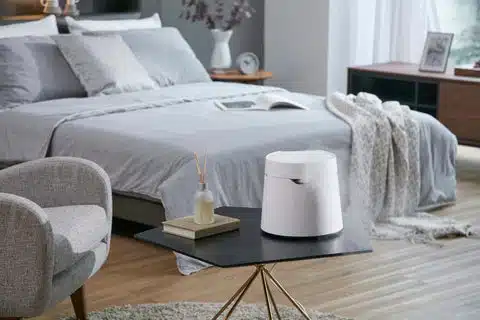
Troubleshooting Tips
Now that you know some alternatives to placing a humidifier near your bed, you must know the potential troubleshooting tips for using a humidifier. If you experience any issues with your humidifier, there are several steps you can take to diagnose and resolve them.
First, if your humidifier is making noise while in operation, check that all components have been correctly installed according to manufacturer instructions. Additionally, ensure the filter is clean and not clogged to reduce noise levels. Moving the machine away from walls or furniture may improve its performance.
Regarding humidity level issues, ensure that the desired setting has been selected on the control panel and adjust accordingly. Also, remember that too much moisture can create problems such as condensation buildup and mold growth. Pay attention to what’s considered healthy for your specific environment and set those parameters accordingly.
Finally, water leakage should be addressed quickly since it could cause long-term damage. Ensure all connections are tight but avoid over-tightening; inspect hoses monthly for cracks or wear; and regularly check seals around windows/doors for proper insulation when running a unit in an enclosed space.
Regular maintenance will help prevent these problems from occurring in the first place, so don’t forget about routine upkeep!
Frequently Asked Questions
What Type Of Humidifier Should I Buy?
When buying the right humidifier, there are several things to consider. Depending on your room size and desired features, you need to decide which type of humidifier is best for you. A few key factors can help you decide – from quiet operation to energy efficiency.
One factor to consider when selecting a humidifier is its ability to operate quietly. Many choose cool-mist humidifiers because they allow for adjustable settings and run more quietly than warm-mist models. Warm mists also tend to use more electricity than their relaxed counterparts, so if energy efficiency is essential, you might want to purchase an excellent mist model.
Another option is an ultrasonic humidifier with no moving parts, operating without noise or fan motors. These units are great for smaller spaces such as bedrooms where sound levels should be kept low at night. They’re usually lightweight and compact, making them easy to move around as needed. These devices are often designed with energy-saving features like auto shut-off timers that ensure efficient operation over time.
No matter what type of humidifier you decide on, read up on product reviews before committing to any purchase. Research beforehand will give you the knowledge necessary to select one that meets all your needs while providing quality performance and value for money.
LEVOIT Humidifiers for Bedroom, Quiet (3L Water Tank) Cool Mist Top Fill Essential Oil Diffuser for Baby Nursery and Plants, 360° Nozzle, Rapid Ultrasonic Humidification for Home Large Room, White
LEVOIT OasisMist Smart Cool and Warm Mist Humidifiers for Bedroom Large Room Home, Auto Customized Humidity, Ultrasonic Top Fill Oil Diffuser for Baby and Plants, Quiet, 4.5L, White
42 used from $56.98
LACIDOLL Humidifiers for Large Room Wholehouse Humidifier 1000 sq. ft 4.2 Gal 16L Floor Humidifier 360° Nozzles Cool Mist Ultrasonic Humidifier Output Top Fill Tower Humidifier for Home Office
How Often Should I Change The Water In The Humidifier?
When it comes to humidifiers, one of the most important things to consider is how often you should change the water. This question can be answered by looking at your device’s maintenance instructions and understanding the frequency required for a clean cycle.
Humidifier water changes are essential to keeping your device running smoothly and efficiently. Depending on the make and model of your machine, this could mean changing the water every few days or once per week to maintain optimal humidity levels.
If you notice any bacteria growing inside your unit, you must immediately replace its water supply with fresh water. It’s best practice to keep track of when you last changed out the water so you don’t forget about regular maintenance cycles.
In addition to changing old water for new, emptying and cleaning your machine regularly is essential. This will help eliminate dirt and debris buildup, which can cause poor air quality or damage components over time. Furthermore, cleaning your humidifier regularly helps ensure that no mold or mildew forms within its tank or filter system – both of which require immediate attention if present!
Overall, taking good care of your humidifier is vital for keeping it working correctly and extending its lifespan. Pay close attention to manufacturer recommendations regarding humidifier water replacement frequency.
Always stay up-to-date on necessary maintenance procedures like emptying reservoirs, washing filters, etc., to maximize efficiency and safety.
Can I Use A Humidifier In A Small Bedroom?
Humidifiers can be a great addition to any home, particularly in small bedrooms. But with their size also come some placement considerations to ensure maximum safety and effectiveness.
When using a humidifier in a small bedroom, you need to consider several factors, such as the right size of the unit for your specific room, how close it should be relative to other furniture and fixtures, and what type of humidifier is best suited for your space.
When selecting a humidifier for your small bedroom, make sure that its capacity fits the size of your room. Having too large an appliance in a smaller area could lead to higher humidity levels than desired.
It’s also essential to consider what kind of humidifier will provide the most efficient performance given the layout of your bedroom – evaporative models tend to work better in larger rooms.
In contrast, ultrasonic or impeller ones may do better in tight spaces due to their quiet operation and low maintenance requirements.
Once you have chosen which model works best for your needs, you’ll want to consider where exactly it should go within the bedroom.
- Bedroom humidifier placement is critical for optimal comfort and safety; here are five tips on how to properly place yours:
- Keep away from direct sources of heat like radiators or heating vents since this can cause condensation buildup inside the device;
- Place it at least two feet away from furniture and walls so moisture isn’t trapped around them;
- Don’t put it near windows because this could create dampness indoors;
- Make sure not to block airflow by placing items on top or directly next to it;
- Keep out of reach from children or pets who might accidentally knock over the unit.
Considering all these precautions, you can rest assured that your new purchase will bring comfort and peace of mind for years.
Is It Safe To Run A Humidifier Overnight?
When it comes to humidifier safety, one of the most common questions is whether running a humidifier overnight is safe. Generally speaking, running your humidifier at night can improve indoor air quality and prevent specific health effects caused by dryness in the air.
However, some critical considerations when using a humidifier during sleep hours should be considered before making this decision.
First, it’s essential to understand proper usage instructions for your specific humidifier model. Many models will have guidelines regarding how often water needs to be replaced and what humidity levels need to be maintained for optimal effectiveness.
It’s also important to consider any potential noise disturbances from your device and ensure that you keep up with regular cleaning and maintenance so that mold does not develop inside the unit.
Finally, if you decide to use a humidifier overnight, ensure that you have correctly monitored the humidity levels to maintain healthy levels throughout the night without over-humidifying your bedroom space. Too much moisture in the air could lead to increased dust mite activity and other allergens, which may cause adverse health effects over time. Therefore, while running a humidifier overnight can offer many benefits, careful consideration must always be given when determining its usage frequency and monitoring water levels within the device.
What Is The Best Way To Clean A Humidifier?
Keeping your humidifier clean is essential for preventing mold and bacteria growth. To ensure it continues to work correctly, you need to know the best way to clean it.
Here are some tips on how to do proper cleaning for a humidifier so you can enjoy its benefits:
- Clean the humidifier regularly – Empty any water left in the tank before each use and rinse it thoroughly with warm water after every cycle or once a week.
- Use mild detergent and white vinegar – When cleaning your humidifier, use only mild detergents such as dish soap or white vinegar diluted with water. Avoid harsh chemicals since they may corrode parts and cause damage over time.
- Dry entirely before storing – After every cleaning session, let your unit dry completely before putting it away. Otherwise, you risk encouraging bacterial growth and other problems when humidity builds up inside the unit during storage periods.
These steps will ensure that your humidifier stays free from dirt and dust buildup, allowing it to perform optimally at all times!
Furthermore, regular maintenance will help extend the device’s lifespan while keeping your air quality safe from potential airborne contaminants like mold spores and harmful microorganisms.
LEVOIT Humidifiers for Bedroom, Quiet (3L Water Tank) Cool Mist Top Fill Essential Oil Diffuser for Baby Nursery and Plants, 360° Nozzle, Rapid Ultrasonic Humidification for Home Large Room, White
LEVOIT OasisMist Smart Cool and Warm Mist Humidifiers for Bedroom Large Room Home, Auto Customized Humidity, Ultrasonic Top Fill Oil Diffuser for Baby and Plants, Quiet, 4.5L, White
42 used from $56.98
LACIDOLL Humidifiers for Large Room Wholehouse Humidifier 1000 sq. ft 4.2 Gal 16L Floor Humidifier 360° Nozzles Cool Mist Ultrasonic Humidifier Output Top Fill Tower Humidifier for Home Office
Q: Where is the best place to put a humidifier?
A: The best location to place your humidifier is on a flat, elevated surface, away from the walls. It is recommended to place it at least 3 feet (0.9 meters) away from the walls and other objects to ensure even humidification around the room.
Q: Can I put a humidifier on the floor?
A: You can place your humidifier on the floor, but elevating it to prevent damage to carpets or rugs is better. If you prefer to keep it on the floor, ensure it is placed on a tray or mat to catch any potential leaks.
Q: Is it possible to place a humidifier in the living room?
A: Yes, you can put a humidifier in your living room to increase the humidity level in the air. Just be sure to place it away from electronic devices and furniture that may be damaged by excess moisture.
Q: Can I put my humidifier on a table?
A: Yes, placing your humidifier on a table is a good option if it is elevated and away from the walls. This will help prevent water damage to furniture and walls.
Q: What is the best placement for a humidifier in your bedroom?
A: For the best results, the ideal spot for a humidifier in your bedroom is on a nightstand, within 3-4 feet of your bed. Make sure to keep the humidifier away from the bed to avoid any accidents.
Q: Can I put a humidifier in the center of the room?
A: Yes, placing a humidifier in the center of the room may help to distribute the moisture evenly throughout the space. Just make sure it is placed away from any furniture or electrical appliances.
Q: Should I place the humidifier near me if I want to use it at night?
A: It is recommended to place the humidifier on a nightstand within a few feet of your bed but not directly beside you. This will help keep your sleep environment comfortable and safe.
Q: What is the best type of humidifier for a bedroom?
A: The best type of humidifier for your bedroom depends on your preference, but many people find a warm mist or ultrasonic humidifier suitable. Choosing a portable humidifier to move around the room quickly is also advisable.
Q: Can I keep my humidifier on all night?
A: You can keep your humidifier on all night to maintain a comfortable humidity level in your bedroom. Just be sure to refill the water tank and clean the device regularly to prevent mold growth.
Q: Do I need a humidifier if I live in a humid climate?
A: If you live in a humid climate, you may not need a humidifier, but it’s still good to keep it around. Dry indoor heating systems during winter can reduce humidity levels so that a humidifier can relieve dry skin, allergies, and other respiratory problems.
Conclusion
First, choosing the right type of humidifier for your bedroom is essential. An ultrasonic or evaporative one might be best if you have a small space.
Then, make sure to change the water regularly and clean it frequently. Running a humidifier overnight is also safe if you don’t put it too close to your bed.
When placing a humidifier in your bedroom, keep it at least three feet away from your head while sleeping. This will help ensure you don’t experience any adverse effects, such as coughing or sneezing due to dry air irritating your respiratory system.
Additionally, if you opt for an electric model, ensure no extension cords are near the device so you won’t get shocked in your sleep.
A humidifier can offer many benefits, including better sleep quality and overall health. However, when deciding where to place yours, remember that safety should always come first!
Make sure it is far enough away from your head to avoid irritation but close enough so that its mist reaches its intended destination – keeping the air moist and comfortable throughout the night.
LEVOIT Humidifiers for Bedroom, Quiet (3L Water Tank) Cool Mist Top Fill Essential Oil Diffuser for Baby Nursery and Plants, 360° Nozzle, Rapid Ultrasonic Humidification for Home Large Room, White
AquaOasis™ Cool Mist Humidifier (2.2L Water Tank) Quiet Ultrasonic Humidifiers for Bedroom & Large room - Adjustable -360 Rotation Nozzle, Auto-Shut Off, Humidifiers for Babies Nursery & Whole House
$29.96 in stock
2 used from $26.96
LEVOIT OasisMist Smart Cool and Warm Mist Humidifiers for Bedroom Large Room Home, Auto Customized Humidity, Ultrasonic Top Fill Oil Diffuser for Baby and Plants, Quiet, 4.5L, White
42 used from $56.98
LEVOIT 4L Humidifiers for Bedroom Large Room & Essential Oil Diffuser, Quiet Cool Mist for Home, Baby and Plants, Last up to 40Hours, Dual 360° Rotation Nozzles, Handle Design, Auto Shut Off, Blue
6.5L Humidifiers for Large Room Bedroom, Top Fill Humidifier for Baby, Cool Mist Humidifiers for Plants Indoor, Pet, Home Lasts Up to 54 Hours, Portable Humidifier-Easy To Clean-Quiet with Nightlight
Pure Enrichment® MistAire™ Silver Ultrasonic Cool Mist Humidifier for Bedroom, Office, Nursery & Indoor Plants - Lasts Up to 25 Hours, Whisper-Quiet Operation, Optional Night Light, & Auto Shut-Off
$39.99 in stock
Vicks Filter-Free Ultrasonic Cool Mist Humidifier, Medium Room, 1.2 Gallon Tank-Humidifier for Baby and Kids Rooms, Bedrooms and More
$59.95 in stock
8 used from $48.75
LACIDOLL Humidifiers for Large Room Wholehouse Humidifier 1000 sq. ft 4.2 Gal 16L Floor Humidifier 360° Nozzles Cool Mist Ultrasonic Humidifier Output Top Fill Tower Humidifier for Home Office
LEVOIT Humidifiers for Bedroom Large Room (2.4L Water Tank), Cool Mist for Home Whole House, Adjustable 360° Rotation Nozzle, Ultrasonic, Auto Shutoff, Night Light, BPA-Free, Pink
Humidifiers for Bedroom, raydrop Cool Mist Humidifiers for Babies, 1.70L Quiet Ultrasonic Humidifier, Space-Saving, Filterless, Auto Shut Off - (0.45 Gallon, US 110V)
$25.99 in stock

